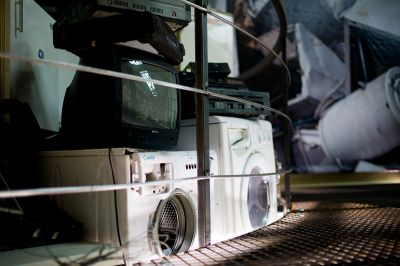New technology to boost rare earths recycling

Strefa zła
By MultiComm (Own work) [CC BY-SA 3.0 (http://creativecommons.org/licenses/by-sa/3.0) or GFDL (http://www.gnu.org/copyleft/fdl.html)], via Wikimedia Commons
Rare earth metals have specific electronic and magnetic properties that make them an essential component of many of today’s high tech electronic devices, but recycling these components is still very challenging. However, new developments by EU-funded researchers will make it simpler to recover these vital materials, and so lead to increased levels of recovery from end-of-life products.
Rare earths or rare earth elements (REEs) are a group of 17 chemically
similar metallic elements that are used extensively in everyday life.
They are part of mobile phones, hard drives, hybrid cars and other
products in high demand. Production of REEs is now concentrated in only a
few countries and Europe has no production facilities, and supply and
cost volatility pose a risk to industry.
Europe has some potentially exploitable natural resources of rare earths. Still, recycling of scarce materials like neodymium from end-of-life products is a strategic necessity. Given the importance of these to modern living, the EU is funding research to make recycling a more feasible option.
REMANENCE (Rare earth magnet recovery for environmental and resource protection) is an ambitious project aiming to dramatically increase the amount of rare earth magnets recovered from existing waste streams. The focus is on recovering and recycling neodymium-iron-boron (NdFeB) magnets.
Advanced sensing and mechanical separation techniques are developed to recover these rare earth magnets from electrical and electronic equipment. Among other techniques, hydrogen has been explored as a processing agent to decrepitate NdFeB magnets into a hydrogenated powder.
This powder can then be extracted mechanically from the obsolete devices and processed further using advanced sieving processes. Researchers have produced magnets that have comparable magnetic characteristics of new magnets using the recycled powder in the existing manufacturing process.
REMANENCE researchers also estimated the energy and environmental impact of producing rare earth neodymium for magnets by recycling end-of-life products versus mining the same amount of virgin material. In the cases considered, recycling used significantly less energy than mining.
Nonetheless, recycling REEs is not as easy as recycling aluminium for example, which already has an established market for the recycling and remanufacture – there are challenges at nearly every level. Rare earths are present in small amounts, but the quantities are expected to increase with increased production of electronic equipment, but as equipment gets smaller, so do the amounts of materials used per item. Historically, technical challenges have been substantial, and there has been little opportunity to establish a supply chain for the recovery of these valuable materials.
The REMANENCE project is trying to develop an efficient route for the recovery of NdFeB magnets from waste streams before this valuable material is lost to landfill. Once established, the EU will have a secondary source of rare earths, which will support the growth of the bonded magnet industry in Europe.
published: 2015-09-07

